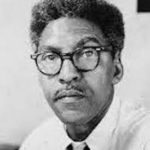 Bayard Rustin (March 17, 1912 – August 24, 1987) was an American leader in social movements for civil rights, socialism, nonviolence, and gay rights.
Bayard Rustin (March 17, 1912 – August 24, 1987) was an American leader in social movements for civil rights, socialism, nonviolence, and gay rights.
On the morning of August 28, 1963, Dr. Martin Luther King Jr. spoke to a crowd of more than 200,000 people from the steps of the Lincoln Memorial. Marking the 100-year anniversary of Lincoln’s delivery of the Gettysburg Address, King hoped to mend the racial fractures within the country. The crowds had gathered for the March on Washington for Jobs and Freedom, the platform for his seminal “I Have a Dream” speech.
While King spoke as the face of the civil rights movement, another man stood behind the scenes, an indispensable force within the movement. He was Bayard Rustin, a man whose life was shaped by the very prejudices the movement fought against, not only because of his race, but also because he was gay. Rustin would spend his life fighting for the rights of others, even while facing discrimination of his own.
To the hundreds of thousands who were bused to Washington for the march, Rustin was synonymous with the movement. After all, he was the march’s chief organizer. “Rustin [organized] this march in an eight-week period, without cell phones, without email, without faxes. So he and his team [were] working the phones hard, they [were] typing letters constantly,” says Michael G. Long, editor of I Must Resist: Bayard Rustin’s Life in Letters and co-author of Bayard Rustin: The Invisible Activist. “From what I hear, the headquarters was in sheer chaos all the time. And Rustin thrived in an environment like that.”
It’s no surprise that Rustin was able to find composure in chaos. Born in 1912 and raised by his grandparents in West Chester, Pennsylvania, Rustin learned Quaker values of nonviolence and peace from an early age. His confidence in those beliefs and in himself were reinforced by his grandmother, Julia Rustin, who affirmed his sexuality—a response that was nearly unheard of at the time.
In 1937, Rustin went to City College of New York, where he joined the Young Communist League because he was attracted to the league’s progressive views on racial issues. But when the group’s focus shifted with the start of World War II to supporting the Soviet Union as opposed to racial injustice in the U.S., Rustin left the organization. Rustin was staunchly against the war and would be arrested and jailed in 1944 as a “conscientious objector” after refusing to register for the draft.
In fact, it was Randolph who persuaded Rustin to meet with King in Montgomery, Alabama, in 1956, to show support for the Montgomery Bus Boycott. A young King would be forever changed after his encounter with Rustin.
“Dr. King had read Gandhi, but at that point he hadn’t accepted pacifism as a way of life. And so when Rustin arrived in Montgomery, Dr. King’s home was full of guns,” Long explains. “It was Bayard Rustin, and a few other pacifists, who really encouraged Dr. King to accept pacifism as a way of life.”
At the urging of Rustin, pacifism and nonviolence would become cornerstones of the Civil Rights Movement. But the meeting would mark the beginning of a long, sometimes tenuous relationship between the two.
When they met, King was aware of Rustin’s sexual orientation, and of Rustin’s 1953 arrest on a morals charge. However, Rustin showcased brilliant strategies and organization skills—areas where King, while a rousing speaker and a strong leader, wasn’t as strong. So Rustin’s sexual orientation was overlooked—at least for the time being.
Rustin was a part of King’s inner circle as the Civil Rights Movement grew in the 1950s, but others considered him a liability. Tensions came to a head, and the worst fears of civil rights activists were realized at the 1960 Democratic National Convention.
Randolph, King, and Rustin had begun arrangements to march at the Democratic National Convention of presidential candidate John F. Kennedy and his running mate Lyndon B. Johnson in Los Angeles, protesting the party’s lackluster position on civil rights. In response, Democratic leadership sent black congressman Adam Clayton Powell to stop the march before it happened. As a result, Rustin resigned from Southern Christian Leadership Conference.
Rustin continued his work with Randolph on civil rights issues, outside of the umbrella of the SCLC. During the years that Rustin wasn’t involved in organizing marches, protests and demonstrations, from 1960 to 1963, the movement saw little progress. King recognized that the movement so many had sacrificed their lives for was losing steam, and slowly reintegrated Rustin during the Birmingham Campaign of 1963. This way, when the March on Washington—a proposal made by Randolph the year prior—would start to take shape, Rustin would already be involved.
Unfortunately for Rustin, detractors from within the movement still opposed his involvement. When it was proposed that Rustin organize a re-envisioned version of the March on Washington that had been canceled 20 years prior, Roy Wilkins, Executive Secretary of the NAACP, was adamantly opposed.
With Rustin at the helm of the March on Washington, they would encounter questions about his personal background. But there was no one better suited to make the march the historic event that it was intended to be. So, King and John Lewis, a member of the Student Non-violent Coordinating Committee at the time, came up with a plan.
Instead of directly involving Rustin, King and Lewis held a caucus to nominate Randolph to lead the march. Randolph, a respected figure in the movement, wouldn’t garner opposition from others.
“But King and Lewis also knew that if Randolph became the official director of the march, he would appoint Bayard as his deputy,” says Long. “And Bayard would really be the one who would lead the march.”
So, with Randolph as the director and Rustin as his deputy, arrangements for the march were underway. And once again, Rustin’s past and personal life were used to try and stop the movement. Senator Strom Thurmond of South Carolina brought nationwide media attention to Bayard after claiming that the march was being organized by “Communist, draft-dodger and homosexual.”
But it would seem that the impact of what was once the movement’s Achilles’ heel had lost its effectiveness. Not only did King come out in support of Rustin when questioned by the media, all of the leaders within the movement did. Even Wilkins put his reservations aside for the sake of progress.
The march went on to be more successful than anyone could’ve imagined, and marked a turning point for both the country and for Rustin.
“It came at the end of a summer of terror in the South. The assassination of Medgar Evers, the Birmingham fire hoses and dogs. There was a lot of discouragement and frustration,” Naegle recalls. “Along came the March on Washington, and I think it really re-energized people, inspired them, lifted up their hope again and renewed the spirit.” Following the success of the march, Rustin and King would continue to work together for years.
Many years after the March on Washington and Dr. King’s assassination, Rustin would continue his role in activism, speaking at events for gay rights in the 1980s. It was also during this time, the last years of his life, that Rustin gave an interview with the Washington Blade, recalling the duality of being both black and gay in the Civil Rights Movement and how that shaped his refusal to hide his sexual orientation.
Rustin died on August 24, 1987, but his fight for nonviolence lived on among the countless people inspired by the 1963 March on Washington. In 2013, President Barack Obama posthumously awarded Rustin the Presidential Medal of Freedom for his unyielding career in civil rights activism.
Information is from History.com written by Thad Morgan
